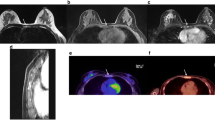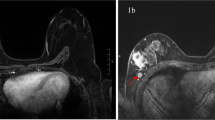Abstract
Objectives
Incidental extra-mammary findings in breast Magnetic Resonance Imaging (MRI) may be benign in nature, but may also represent a metastasis or another important lesion. We aimed to analyse the prevalence and clinical relevance of these unexpected findings.
Methods
A retrospective review of 1535 breast MRIs was conducted. Only axial sequences were reassessed. Confirmation examinations were obtained in all cases.
Results
285 patients had a confirmed incidental finding, which were located in the liver (51.9%), lung (11.2%), bone (7%), mediastinal lymph nodes (4.2%) or consisted of pleural/pericardial effusion (15.4%). 20.4% of incidental findings were confirmed to be malignant. Positive predictive value for MRI to detect a metastatic lesion was high if located within the bone (89%), lymph nodes (83%) and lung (59%), while it was low if located within the liver (9%) or if it consisted of pleural/pericardial effusion (6%). The axial enhanced sequence showed superior sensitivity to unenhanced images in detecting metastatic lesions, especially if only smaller (≤10 mm.) lesions were considered.
Conclusions
The prevalence of metastatic incidental extra-mammary findings is not negligible. Particular attention should be to incidental findings located within the lung, bone and mediastinal lymph nodes.







Similar content being viewed by others
References
Schnall MD, Blume J, Bluemke DA et al (2006) Diagnostic architectural and dynamic features at breast MR imaging: multicenter study. Radiology 238:42–53
Warren RM, Pointon L, Thompson D et al (2005) UK Magnetic Resonance Imaging in Breast Screening (MARIBS) Study Group Reading protocol for dynamic contrast-enhanced MR images of the breast: sensitivity and specificity analysis. Radiology 236:779–788
Yabuuchi H, Kuroiwa T, Kusumoto C, Fukuya T, Ohno S, Hachitanda Y (2006) Incidentally detected lesions on contrast-enhanced MR imaging in candidates for breast conserving therapy: correlation between MR findings and histological diagnosis. J Magn Reson Imaging 23:486–492
Yabuuchi H, Matsuo Y, Okafuji T et al (2008) Enhanced mass on contrast-enhanced breast MR imaging: lesion characterization using combination of dynamic contrast-enhanced and diffusion-weighted MR images. J Magn Reson Imaging 28:1157–1165
Sardanelli F, Boetes C, Borisch B et al (2010) Magnetic resonance imaging of the breast: recommendations from the EUSOMA working group. Eur J Cancer 46:1296–1316
Rausch R (2008) Spectrum of extra-mammary findings on breast MRI: a pictorial review. Breast J 14:591–600
Morakkabati-Spitz N, Sondermann E, Schmiedel A et al (2003) Prevalence and type of incidental extramammary findings in MRI of the breast. Rofo 175:199–202
Hill KA, Rosen B, Shaw P, Causer PA, Warner E (2007) Incidental MRI detection of BRCA1-related solitary peritoneal carcinoma during breast screening—A case report. Gynecol Oncol 107:136–9
Watts KA, Watts JR Jr (2007) Incidental discovery of an anterior mediastinal angiomyolipoma. J Thorac Imaging 22:180–1
Beatty JS, Williams HT, Aldridge BA et al (2009) Incidental PET/CT findings in the cancer patient: how should they be managed? Surgery 146:274–281
Cardoso F, Castiglione M (2009) Locally recurrent and metastatic breast cancer: ESMO clinical Recommendations for diagnosis, treatment and follow-up. Ann Oncol Suppl 20:15–18
Gavenonis SC, Roth SO (2010) Role of magnetic resonance imaging in evaluating the extent of disease. Magn Reson Imaging Clin N Am 18:199–206
Olivas-Maguregui S, Villaseñor-Navarro Y, Ferrari-Carballo T et al (2008) Importance of the preoperative evaluation of multifocal and multicentric breast cancer with magnetic resonance imaging in women with dense parenchyma. Rev Invest Clin 60:382–389
Patani N, Mokbel K (2008) The utility of MRI for the screening and staging of breast cancer. Int J Clin Pract 62:450–453
Kuhl C, Kuhn W, Braun M, Schild H (2007) Pre-operative staging of breast cancer with breast MRI: one step forward, two steps back? Breast Suppl 16:S34–44
Brennan ME, Houssami N, Lord S et al (2009) Magnetic resonance imaging screening of the contralateral breast in women with newly diagnosed breast cancer: systematic review and meta-analysis of incremental cancer detection and impact on surgical management. J Clin Oncol 27:5640–5649
Al-Hallaq HA, Mell LK, Bradley JA et al (2008) Magnetic resonance imaging identifies multifocal and multicentric disease in breast cancer patients who are eligible for partial breast irradiation. Cancer 113:2408–2414
vanSonnenberg E, Wroblicka JT, D’Agostino HB et al (1994) Symptomatic hepatic cysts: percutaneous drainage and sclerosis. Radiology 190:387–392
Khalil HI, Patterson SA, Panicek DM (2005) Hepatic lesions deemed too small to characterize at CT: prevalence and importance in women with breast cancer. Radiology 235:872–878
Schwartz LH, Gandras EJ, Colangelo SM, Ercolani MC, Panicek DM (1999) Prevalence and importance of small hepatic lesions found at CT in patients with cancer. Radiology 210:71–74
Blakeborough A, Ward J, Wilson D et al (1997) Hepatic lesion detection at MR imaging: a comparative study with four sequences. Radiology 203:759–765
Yamashita Y, Hatanaka Y, Yamamoto H et al (1994) Differential diagnosis of focal liver lesions: role of spin-echo and contrast-enhanced dynamic MR imaging. Radiology 193:59–65
Hamm B, Thoeni RF, Gould RG et al (1994) Focal liver lesions: characterization with nonenhanced and dynamic contrast material-enhanced MR imaging. Radiology 190:417–423
Roberts CC, Daffner RH, Weissman BN et al (2010) ACR appropriateness criteria on metastatic bone disease. J Am Coll Radiol 7:400–409
Jeong YJ, Kim S, Kwak SW et al (2008) Neoplastic and nonneoplastic conditions of serosal membrane origin: CT findings. Radiographics 28:801–817
Heelan RT (1994) CT and MR imaging in the evaluation of pleural masses. Chest Surg Clin N Am 4:431–450
Author information
Authors and Affiliations
Corresponding author
Rights and permissions
About this article
Cite this article
Rinaldi, P., Costantini, M., Belli, P. et al. Extra-mammary findings in breast MRI. Eur Radiol 21, 2268–2276 (2011). https://doi.org/10.1007/s00330-011-2183-6
Received:
Revised:
Accepted:
Published:
Issue Date:
DOI: https://doi.org/10.1007/s00330-011-2183-6




